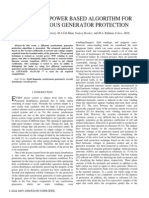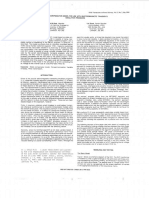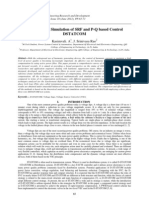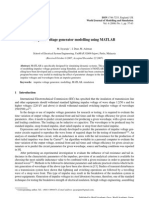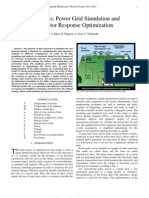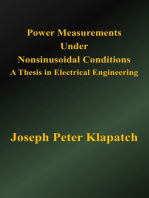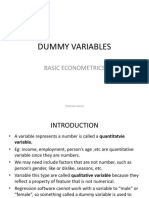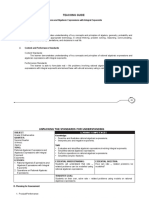Comparative Evaluation Between Theoretical Models For Three-Phase Induction Motor Under Voltage Unbalance
Comparative Evaluation Between Theoretical Models For Three-Phase Induction Motor Under Voltage Unbalance
Uploaded by
Dante HollandaCopyright:
Available Formats
Comparative Evaluation Between Theoretical Models For Three-Phase Induction Motor Under Voltage Unbalance
Comparative Evaluation Between Theoretical Models For Three-Phase Induction Motor Under Voltage Unbalance
Uploaded by
Dante HollandaOriginal Title
Copyright
Available Formats
Share this document
Did you find this document useful?
Is this content inappropriate?
Copyright:
Available Formats
Comparative Evaluation Between Theoretical Models For Three-Phase Induction Motor Under Voltage Unbalance
Comparative Evaluation Between Theoretical Models For Three-Phase Induction Motor Under Voltage Unbalance
Uploaded by
Dante HollandaCopyright:
Available Formats
International Conference on Renewable Energies and Power Quality (ICREPQ13)
Bilbao (Spain), 20
th
to 22
th
March, 2013
Renewable Energy and Power Quality Journal (RE&PQJ)
ISSN 2172-038 X, No.11, March 2013
Comparative Evaluation between Theoretical Models for
Three-Phase Induction Motor under Voltage Unbalance
D. L. R. Hollanda
1
, M. L. S. de Almeida
1
, A. L. Ferreira Filho
1
, A. Goedtel
2
1
Department of Electrical Engineering
UnB, Braslia University
Campus Darcy Ribeiro Asa Norte, Braslia (Brazil) Phone number: +55 61 3107 1043,
e-mail: danteluiz@gmail.com, marialeonor.unb@gmail.com, anesioleles@gmail.com
2
Centro Integrado de Pesquisa em Controle e Automao
UTFPR, Universidade Tecnolgica Federal do Paran
Campus Cornlio Procpio, Avenue Alberto Carazai, Cornlio Procpio, Paran (Brazil) Phone number:+55 43 3520 4000
e-mail: agoedtel@utfpr.edu.br
Abstract. This article presents the results of a comparative
evaluation between representing models of three-phase induction
motor (TIM) in frequency domain, time domain and by artificial
neural networks obtained with laboratory tests. For this, it was
studied torque and efficiency of a 1 HP motor under several
situations of voltage unbalance. Considering that due to high
volume of conditions involved in a study of the performance
behavior of the TIM subjected to unbalances often appeal to
computer simulations, it can be characterize the present study as
essential to select the most appropriate tool which allows results
closer to those acquired in practice.
Key words
Three-Phase Induction Motor, Voltage Unbalance, Time
Domain Model, Frequency Domain Model, Artificial
Neural Networks Model.
1. Introduction
Each time more research institutions, energy utilities and
consumers are more concerned about power quality. This
growing interest justifies the increase of the developed
works about the subject. These studies, in general, aim to
improve required standards for proper functioning of
electrical equipment, as well as the knowledge of its
behavior when supplied by improper voltage source.
Among the possible problems in the supply of electricity,
it can cite the voltage unbalance. About this phenomenon,
many specialists have embarked efforts regarding the
influence of this phenomenon on behavior of the torque
and efficiency of the motor [1]-[6]. In these publications,
one of the aspects of the mentioned phenomenon that has
intensified studies in the area is that numerous
combinations of voltages result in the same value of factor
unbalance [7]. In this case, for achieving reliable results, it
is required a high number of voltage combinations to be
investigated, which inhibits studies only in laboratory. To
overcome this limitation, almost always computer
simulations are employed. In order to not compromise
the results, it is essential a careful selection of a model
for representing the machine.
Based on the aforementioned considerations, the
motivation for developing this work came up, which
presents a comparative evaluation between the theoretical
modeling commonly found in the current literature for
representation of the TIM, namely:
1) Time domain model: [8]-[9];
2) Frequency domain model: [7],[9]-[11]; and
3) Artificial neural networks (ANN): [12]-[15].
Initially, this work shows the concepts related to voltage
unbalance. After, the theoretical assumptions and the
methodology applied in the research are presented.
Having a selection of numerous combinations of
unbalanced voltages, it can be obtained the corresponding
experimental and computational results. Comparing the
acquired computational and experimental results, it is
calculated the discrepancies resulting from use of each
model. This makes possible the identification of the most
appropriate model for analysis of the performance of the
TIM when its voltage source is unbalanced.
2. Voltage Unbalance
Voltage unbalance is defined as any situation where
voltage phasors have different magnitudes from each
other, or lag angles are different from 120 electrical
degrees between them or both situations [16].
In this work, the index of voltage unbalance, VUF
(Voltage Unbalance Factor) is calculated by symmetrical
components method. Analytically, symmetrical
components are defined by the Fortescue matrix, shown in
(1).
(
(
(
(
(
(
(
=
(
(
(
(
2
1
0
2
2
1
1
1 1 1
V
V
V
a a
a a
V
V
V
C
B
A
(1)
Where:
- a is the rotational operator, whose magnitude is equal to
one and its angle is 120;
-
A
V
is the voltage phasor in phase A;
-
B
V
is the voltage phasor in phase B;
-
C
V
is the voltage phasor in phase C;
-
0
V
is the zero sequence component voltage;
-
1
V
is the positive sequence voltage; and
-
2
V
is the negative sequence voltage.
Based on this method, Brazilian Electricity Regulatory
Agency (ANEEL) sets the unbalance factor as (2) and also
determines that the reference value in the distribution
system buses, except for low voltage, must be equal or less
than 2% [17].
% 100 *
1
2
V
V
VUF =
(2)
Voltage unbalance has basically two origins: one related to
the structure of the grid and other related to the load [15].
The unbalance related to the structure is caused by
asymmetry of the electrical system at the level of
transmission and distribution. The lack of transmission
lines transposition and the presence of unbalanced
transformers and unbalanced capacitor banks are examples
of causers of the aforementioned disturbance. Due to the
small variation of the system parameters this type of cause
is practically constant.
The unbalance related to nature of load depends of the
operating characteristics of customers. In this situation, the
existent inequality between phase voltages occurs due to
some factors, for example: presence of unbalanced three-
phase loads, bad single-phase load distribution and
variation on demand cycles of each phase.
On the induction motor, voltage unbalance creates a torque
with opposition to the movement of the rotor, which in
addition to the natural torque, culminates in a pulsing
torque on the axis of the machine. Thus, there is reduction
on the speed and on the resulting torque and increase of
the losses and the temperature of the motor. In this
context, it can be observed the wear of the mechanical
elements of the machine and, consequently, the lifetime
reduction of the TIM.
3. Models of the TIM
In this study, three models are used for analysis of the
behavior of the TIM, namely: time domain model,
frequency domain model and by artificial neural
networks (ANN). The choice of these models is due to
their wide acceptance in the power community.
The computational tool named Matlab/Simulink is used
for time domain model execution. This modeling
employs in its calculations the Park transformation.
Frequency domain model and by ANN are developed in
Matlab script. For frequency domain modeling it is
determined the equivalent circuits of the TIM. Referring
to the ANN modeling, the toolbox of artificial neural
networks contained in Matlab is applied.
A. Time domain modeling
By differential equations, the time domain modeling
makes viable the achievement of electrical and
mechanical parameters that rule the behavior of the motor
over time. Thereby, studies related to dynamic behavior
of the machine becomes feasible.
The present model, which adopts the software
Matlab/Simulink for developing the time modeling study,
was created with a TIM connected to a direct current
generator (DCG) in order to obtain the torque and the
efficiency of a squirrel-cage induction motor.
The parameters for the simulation of the TIM and the
DCG are shown in Table I.
Table I. Required parameters for
simulation in time domain model
Machine Parameter Value
TIM
Nominal power [VA] 1155
Line-line voltage [V] 220
Frequency [Hz] 60
Stator resistance [O] 4.822
Rotor resistance[O] 1.845
Stator inductance [O] 0.878
Rotor inductance[O] 0.448
Mutual inductance [H] 0.161
Number of poles 4
DCG
Armature resistance [O] 4.143
Armature inductance [H] 0.018
Field resistance [O] 212.700
Field resistance [H] 17.200
Mutual inductance [H] 1.358
B. Frequency domain modeling
This is the most classical strategy for representing the
induction motor [12]. Such modeling allows the machine
behavior emulation by equivalent circuits when in steady-
state.
In this strategy, when a TIM is subjected to unbalanced
voltages, two equivalent circuits are employed: the first
associated to the positive sequence voltage, presented in
Figure 4, and the second related to the negative sequence
voltage, exposed in Figure 5.
Figure 4. Positive sequence equivalent circuit.
Where:
-
1
V is the positive sequence voltage;
-
s
R and
s
X are the resistance and reactance per phase of
the stator, respectively;
-
n
R and
mag
X are the resistance and reactance per phase
of the core, respectively;
-
r
R and
r
X are the resistance and reactance per phase of
the rotor, respectively;
- s is the slip; and
-
1 s
I and
1 r
I are the positive sequence current of the stator
and the rotor, respectively.
Figure 5. Negative sequence equivalent circuit
Where:
-
2
V is the negative sequence voltage;
-
2 s
I and
2 r
I are the negative sequence currents of the
stator and the rotor, respectively; and
-
s is the slip of negative sequence, defined in (2).
s s =
2
(2)
Analyzes employing the frequency domain model, for
conditions where there are unbalanced voltages, is
performed by superposition of effects generated by
positive and negative sequence voltages. In practice, the
positive sequence voltage induces a rotating magnetic field
in a direction and negative sequence voltage produces, in
the stator, currents with reverse sequence which induces an
opposite rotating magnetic field.
Regarding the effects of the zero sequence, these are not
meaningful for torque, since parallel phasor voltages does
not generate rotating magnetic field and, therefore, they
do not develop torque [18]. Generally, also there is no
way for circulating the zero sequence current in the
machine, once the motors are often connected in triangle
or ungrounded wye.
C. Artificial Neural Networks Modeling
The ANN system adopted in this work has four networks
in total, namely: starting torque, maximum torque, full-
load torque, and efficiency. Their type is multilayer
perceptron with backpropagation error.
For the structure composition of the ANN, acquisition of
the parameters is realized by 163 laboratory experiments.
In each of these situations, torque and efficiency of the
motor are acquired. Thereby, it is possible to verify the
corresponding behavior of each parameter analyzed.
The inputs for the ANN modeling are the line voltage
magnitudes and the outputs are torque efficiency of the
TIM. In this research, 130 voltage combinations are
admitted for training of the ANN and 33 for verification.
4. Methodology
The simulations and tests proposed in this item aimed to
identify the discrepancies between theoretical models and
results obtained through laboratory experiments. For this
investigation, it was selected the interval of VUF
between 0% and 4% and line voltage range of 201-231 V
with nominal angles in phase voltages. The choice of this
voltage range is due to ANEEL, which establishes as
acceptable the aforementioned levels of voltage for a
system with nominal voltage equal to 220 V [17].
The simulated and tested motor has the following
parameters, provided by the manufacturer: 1 HP,
220/380 V, 4 poles, 60 Hz, 1730 rpm, rated torque equal
to 4.10 N.m and rated current equal to 2.98 A. The
equivalent circuit parameters are the same as shown in
Table I.
In laboratory tests, the TIM was connected to a DCG. By
determining the load of this generator, it was possible to
adjust the TIM to work in nominal condition. In this
situation, the following parameters were measured:
starting torque equal to 11.4 N.m, maximum torque equal
to 11.0 N.m and full-load torque equal to 4.1 N.m.
However, measuring the efficiency was not directly; it
was calculated based on the value of output and input
power. Thereby, in nominal condition, the efficiency was
71.5%.
5. Comparative Evaluation
In this section, experimental and computational results
are shown. In order to compare the experimental values
of torque and efficiency with those obtained by ANN,
frequency and time domain models, 33 voltage
combinations are chosen. In Figures 3, 4 and 5 the results
obtained for starting torque, maximum torque and full-
load torque, respectively, are shown. These figures are in
percentage of rated torque of the TIM.
Fig. 3 Starting torque in relation to V
1
It can be observed in Figure 3 linearity between the
behavior of starting torque and the value of positive
sequence voltage, especially in relation to results of
frequency and time domain models. It is noted a high
correlation between frequency and time domain models.
Most of experimental results have larger values than those
obtained by these two modeling. It is verified, furthermore,
the attempt to approximate results generated by ANN with
experimental values.
Fig. 4 Maximum torque in relation to V
1
As shown in Figure 3, it can be seen in Figure 4 a high
correlation between values obtained by frequency and time
domain models. It is identified in Figure 4 a straight line
with null slope formed by results obtained with ANN. This
is due to the dispersion of experimental values. Also,
considerable differences are observed for the three
modeling.
Fig. 5 Full-load torque in relation to V
1
It can be observed from Figure 5, when specifying V
1
, a
greater variation on the experimental results in comparison
with the computational ones. Furthermore, results obtained
by ANN modeling shows that their behavior have
significantly varied in function of V
1
. The full-load torque
determined by frequency and time domain modeling
tends to increase with the elevation of V
1
. It can be seen
in Figure 5 changes with levels approximately of 15% in
full-load torque by experimental results, while time
domain model indicates a change of approximately 1%.
Figure 6 shows the results obtained for efficiency of
TIM.
Fig. 6 Efficiency in relation to V
1
In Figure 6, considerable differences are verified between
efficiency obtained from simulations in frequency and
time domain models with respect to those acquired
experimentally and by ANN modeling. It can be noted
that results obtained in frequency and time domain
models are closer to values declared by the manufacturer
(around 80%). However, laboratory experiments and
ANN modeling, which was trained and validated with
laboratory tests, provided efficiency close to 70%.
Table II presents the average errors compared to
experimental values, acquired by the studied models.
Also, standard deviations obtained by the modeling for
each parameter are shown.
Table II. Average error and standard deviation between
simulated and experimental parameters.
Parameter Model
Average
Error (%)
Standard
Deviation (%)
Starting
torque
Frequency domain 4.45 5.04
Time domain 2.72 5.17
ANN 2.74 3.54
Maximum
torque
Frequency domain 8.45 5.04
Time domain 13.22 4.92
ANN 4.00 0.20
Full-load
torque
Frequency domain 2.43 0.59
Time domain 2.70 0.25
ANN 2.93 2.40
Efficiency
Frequency domain 15.86 0.73
Time domain 14.48 0.96
ANN 0.65 0.00
From Table II and considering the starting torque, it can
be verified that smaller average errors for this parameter
are obtained by time domain and ANN modeling.
Starting torque provided by frequency domain modeling
achieves average errors close to 4%. This percentage is
around 60% higher compared to errors assigned by the
other two models, which are close to 2.7%. Investigating
the standard deviations for the aforementioned torque,
ANN modeling has the lowest value (around 3.5%) while
the other two models provide standard deviations near to
5%.
Additionally, in relation to maximum torque, it is observed
the lowest average error equal to 4% for ANN modeling
while frequency and time domain models exhibit average
errors of 8.45% and 13.22%, respectively. As observed for
starting torque, the standard deviation obtained by ANN
model for maximum torque is almost zero, while the
remaining two are around 5%. These results are provoked
by high dispersion found in experimental results.
For full-load torque, the three modeling present maximum
average error around 3%. However, in relation to standard
deviations, the ANN model has obtained a value close to
2% and values less than 1% are found for frequency and
time domain models.
For efficiency, large discrepancies are noted between
average errors obtained by frequency and time domain
models in respect to those found by ANN modeling. The
average errors for frequency and time domain modeling
are around twenty times greater than the results obtained
by the simulation in ANN model, which has obtained
average error and standard deviation less than 1%.
6. Conclusions
This paper presented theoretical and experimental results
for the performance of a three-phase induction motor
supplied with different conditions of voltage unbalance.
Three theoretical modeling with wide acceptance in power
community were employed in this research, namely: time
domain model, frequency domain model and ANN model.
Results of laboratory experiments were adopted as
reference for comparative evaluation between the models.
Discrepancies in the order of 13% for maximum torque
and of 16% for efficiency were observed when analyzing
the theoretical results obtained by frequency and time
domain models, respectively. It was verified that the model
developed in time domain has greater fidelity to practical
results when dealing with full-load torque.
As noticed, experimental values for efficiency had
discrepancies around 15% and 16% compared to results
found by time and frequency domain models. Such
differences are due to the fact that results obtained by these
models are closer to the ones furnished by the
manufacturer. Moreover, efficiency values found by ANN
proved to be close to those obtained experimentally.
From analyzes performed in this study, ANN modeling
proved to be more reliable for the behavior performance of
the TIM in three of four parameters investigated:
maximum torque, full-load torque and efficiency.
References
[1] C. Y. Lee, B. K. Chen, W. J. Lee and Y. F. Hsu, Effects of
Various Voltages on the Operation Performance of an
Induction Motor under the Same Unbalance Factor
Condition, In: Industrial and Commercial Power Systems
Technical Conference (1997), pp. 5159.
[2] Y. J. Wang, Analysis of Effects of Three-Phase Voltage
Unbalance on Induction Motors with Emphasis on the
Angle of the Complex Voltage Unbalance Factor, In: IEEE
Power Engineering Review (2001), vol. 21, no. 9, pp. 270
275.
[3] A. Siddique, G. S. Yadava and B. Singh, Effect of Voltage
Unbalance on Induction Motors, In: Conference Record of
the 2004 IEEE International Symposium on Electrical
Insulation, Indianapolis (2004), pp.26-29.
[4] P. G. Kini and R. C. Bansal, A Novel Approach Toward
Interpretation and Application of Voltage Unbalance
Factor, In: IEEE Transactions on Industrial Electronics
(2007), vol. 54, no 4, pp. 23152322.
[5] P. G. Kini and R. C. Bansal, Effect of Voltage and Load
Variations on Efficiencies of a Motor-Pump System, In:
IEEE Transactions on Energy Conversion (2010), vol. 25,
no 2, pp. 287292.
[6] M. Anwari and A. Hiendro, New Unbalance Factor for
Estimating Performance of a Three-Phase Induction Motor
With Under- and Overvoltage Unbalance, In: IEEE
Transactions on Energy Conversion (2010), vol. 25, no 3,
pp. 619625.
[7] J. Faiz, H. Ebrahimpour and P. Pillay, Influence of
Unbalanced Voltage on the Steady-State Performance of a
Three-Phase Squirrel-Cage Induction Motor, In: IEEE
Transactions on Energy Conversion (2004), vol. 19, no. 4,
pp. 657662.
[8] O. C. N. Souto, J. C. de Oliveira, J. H. Vilela and L. M.
Neto, Efeitos da Qualidade da Energia Eltrica sobre a
Operao de Motores de Induo Trifsicos, In: II
Brazilian Conference about Power Quality, So Loureno
(1997).
[9] J. Pedra, Estimation of typical squirrel-cage induction
motor parameters for dynamic performance simulation, In:
IEE Proceedings Generation, Transmission and
Distribution (2006), vol. 153, no 2, pp. 137146.
[10] J. Pedra, On the Determination of Induction Motor
Parameters From Manufacturer Data for Electromagnetic,
In: IEEE Transactions on Power Systems (2008), vol. 23,
no 4., pp. 17091718.
[11] O. C. N. Souto, Modelagem e Anlise do Desempenho
Trmico de Motores de Induo Sob Condies No Ideais
de Alimentao, PhD Thesis, Faculty of Electrical
Engineering, Uberlndia, Brazil (2001), pp. 323.
[12] A. Goedtel, Estimativa de torque de carga aplicado em
eixos de motores de induo trifsicos atravs de redes
neurais artificiais, Dissertation, Faculty of Engineering,
University of So Paulo, Bauru, Brazil (2003), pp. 141.
[13] A. Goedtel, I. N. da Silva, P. J. A. Serni, Uma abordagem
neural para estimativa de torque em motores de induo,
In: Journal Control & Automation (2006), vol.17, no. 3, pp.
364380.
[14] A. Goedtel, Estimador Neural de Velocidade Para
Motores de Induo Trifsicos, PhD Thesis, School of
Engineering of So Carlos, University of So Paulo, So
Carlos, Brazil (2007), pp. 159.
[15] J. M. Matos, Avaliao dos Efeitos do Desequilbrio de
Tenso Sobre os Motores de Induo Trifsicos, Graduate
work, Faculty of Technology, University of Braslia, Brazil
(2012), pp. 79.
[16] A. L. Ferreira, Anlise do Comportamento do Fator de
Desequilbrio Frente a Variao da Amplitude e do ngulo
da Tenso, PhD Thesis, Faculty of Technology, University
of Braslia, Braslia, Brazil (2008), pp. 163.
[17]ANEEL. Proceedings of Distribution of Electrical Energy
in the National Electrical System PRODIST; Module 8
Power Quality, Braslia, Brazil (2012), p. 30.
[18] I. BARBI,. Teoria Fundamental do Motor de Induo,
UFSC Publisher, Florianpolis, Brazil (1985), pp. 220.
You might also like
- LP For Stat and ProbDocument4 pagesLP For Stat and ProbJunilyn SamoyaNo ratings yet
- Modelling of Power Transformer FaultsDocument7 pagesModelling of Power Transformer FaultselizabethloayzaNo ratings yet
- A New Approach To Three-Phase Asynchronous Motor Model For Electric Power System AnalysisDocument12 pagesA New Approach To Three-Phase Asynchronous Motor Model For Electric Power System AnalysisInternational Journal of Power Electronics and Drive SystemsNo ratings yet
- Final ANN - KPECDocument6 pagesFinal ANN - KPECJonathan Muñoz TaboraNo ratings yet
- A Wavelet Power Based Algorithm For Synchronous Generator ProtectionDocument6 pagesA Wavelet Power Based Algorithm For Synchronous Generator ProtectionsunitharajababuNo ratings yet
- Systematization of The Simulation Process of TransDocument17 pagesSystematization of The Simulation Process of TransMichael NgoNo ratings yet
- Machine Learning Based Method For Impedance EstimationDocument6 pagesMachine Learning Based Method For Impedance Estimationjohnmarklicuanan12No ratings yet
- 011 Wang ButlerDocument6 pages011 Wang ButlerConstantin DorinelNo ratings yet
- Simulation For A 3 Phase Induction Motor Under Unbalanced ConditionsDocument4 pagesSimulation For A 3 Phase Induction Motor Under Unbalanced ConditionsRadu BabauNo ratings yet
- Uncertainty Analysis of Power System Components Based On Stochastic Response SurfacesDocument8 pagesUncertainty Analysis of Power System Components Based On Stochastic Response SurfacesHassan Ali Al SsadiNo ratings yet
- Mathematical Model of Asynchronous Machine PDFDocument8 pagesMathematical Model of Asynchronous Machine PDFkh_chu_1No ratings yet
- 418 DallasDocument6 pages418 DallasbaradaranhamidNo ratings yet
- Three Phase Synchronous GeneratorDocument29 pagesThree Phase Synchronous GeneratorYazan YousefNo ratings yet
- Applsci 08 01073 PDFDocument13 pagesApplsci 08 01073 PDFErsi Ago100% (1)
- Dissipativity Properties of Detailed Models of Synchronous GeneratorsDocument6 pagesDissipativity Properties of Detailed Models of Synchronous Generatorssridhar_n@email.comNo ratings yet
- Effect of Unbalanced Voltage On Operation of Induction Motors and Its DetectionDocument4 pagesEffect of Unbalanced Voltage On Operation of Induction Motors and Its DetectionirfandudeNo ratings yet
- Generalized Dynamic and Steady State Analysis of Self Excited Induction (SEIG)Document6 pagesGeneralized Dynamic and Steady State Analysis of Self Excited Induction (SEIG)harisimpNo ratings yet
- 13IPST121Document7 pages13IPST121Anonymous 9VcxlFErfNo ratings yet
- A Static Compensator Model For Use With Electromagnetic Transients Simulation ProgramsDocument10 pagesA Static Compensator Model For Use With Electromagnetic Transients Simulation ProgramsjeffguitarNo ratings yet
- Modeling and Simulation of SRF and P-Q Based Control DstatcomDocument7 pagesModeling and Simulation of SRF and P-Q Based Control DstatcomIJERDNo ratings yet
- MATLAB in Model-Base Design For Slip Energy Recovery of Induction MotorDocument6 pagesMATLAB in Model-Base Design For Slip Energy Recovery of Induction Motorsanjay kumar yadavNo ratings yet
- Faculteit Der Elektrotechniek: Modelling and Identification of Single-And Double-Cage Induction MachinesDocument144 pagesFaculteit Der Elektrotechniek: Modelling and Identification of Single-And Double-Cage Induction MachinesAmatek Teekay 特克纳No ratings yet
- Fast Detection Technique For Voltage Unbalance in Three-Phase Power SystemDocument13 pagesFast Detection Technique For Voltage Unbalance in Three-Phase Power SystemInternational Journal of Power Electronics and Drive SystemsNo ratings yet
- A Novel Parameter Estimation Method For Metal Oxide Surge Arrester ModelsDocument21 pagesA Novel Parameter Estimation Method For Metal Oxide Surge Arrester ModelsClarkxNo ratings yet
- Fernandez Diaz Surge ArresterDocument5 pagesFernandez Diaz Surge ArresterBrian Zuñagua FloresNo ratings yet
- Factors Affecting StabilityDocument8 pagesFactors Affecting StabilitySteve MusarurwaNo ratings yet
- Calculation of Total Current Harmonic Distortion by PWM Method For Permanent Magnet Synchronous MotorsDocument4 pagesCalculation of Total Current Harmonic Distortion by PWM Method For Permanent Magnet Synchronous MotorsShakeel RanaNo ratings yet
- Harmonic Reduction of Arc Furnaces Using D-Statcom: S.Pushpavalli, A. CordeliasumathyDocument8 pagesHarmonic Reduction of Arc Furnaces Using D-Statcom: S.Pushpavalli, A. CordeliasumathyIOSRJEN : hard copy, certificates, Call for Papers 2013, publishing of journalNo ratings yet
- Performance Analysis of A Three-Phase Induction Motor Under Non-Sinusoidal and Unbalanced ConditionsDocument5 pagesPerformance Analysis of A Three-Phase Induction Motor Under Non-Sinusoidal and Unbalanced ConditionsRavinder RangaNo ratings yet
- Simulation of IEEE First Benchmark Model For SSR StudiesDocument4 pagesSimulation of IEEE First Benchmark Model For SSR StudiesPabloNalogowskiNo ratings yet
- 10 1 1 132Document7 pages10 1 1 132Sangrama Kesari NayakNo ratings yet
- Identification of Variable Frequency Induction Motor Models From Operating DataDocument8 pagesIdentification of Variable Frequency Induction Motor Models From Operating Datani60No ratings yet
- Characterization of Voltage Sags in Industrial Distribution SystemsDocument8 pagesCharacterization of Voltage Sags in Industrial Distribution SystemsHamzah RezaNo ratings yet
- Assignment 03 RMDocument7 pagesAssignment 03 RMijazNo ratings yet
- Voltage SagDocument6 pagesVoltage SagcaetanoNo ratings yet
- Comparative_analysis_between_synchronous_and_induction_machines_for_distributed_generation_applicationsDocument11 pagesComparative_analysis_between_synchronous_and_induction_machines_for_distributed_generation_applicationspharuoNo ratings yet
- Pulse August 2014Document16 pagesPulse August 2014lets_share_sthNo ratings yet
- 288 EstimaDocument6 pages288 EstimaTarun KathuriaNo ratings yet
- Power Quality Improvement of Grid Interconnected 3-Phase 4-Wire Distribution System Using Fuzzy Logic ControlDocument5 pagesPower Quality Improvement of Grid Interconnected 3-Phase 4-Wire Distribution System Using Fuzzy Logic ControlJeyanthi GanesanNo ratings yet
- A Method For Constructing Reduced Order Transformer Models For System Studies From Detailed Lumped Parameter Models Ml12088a497Document7 pagesA Method For Constructing Reduced Order Transformer Models For System Studies From Detailed Lumped Parameter Models Ml12088a497cristian1961No ratings yet
- Exp 10 - Power System Stability - TeacherDocument6 pagesExp 10 - Power System Stability - TeacherprinceiutNo ratings yet
- Measurement System For Transformer Inrush Current Higher Harmonics DeterminationDocument6 pagesMeasurement System For Transformer Inrush Current Higher Harmonics DeterminationnmulyonoNo ratings yet
- Auto Transformer Insulation Coordination StudyDocument6 pagesAuto Transformer Insulation Coordination StudyrajfabNo ratings yet
- Steady State Analysis of Wind TurbineDocument7 pagesSteady State Analysis of Wind TurbineKhy-khy PutraNo ratings yet
- Eee-Vi-power System Analysis and Stability (10ee61) - NotesDocument119 pagesEee-Vi-power System Analysis and Stability (10ee61) - NotesNurul Islam Faruk0% (1)
- Power Transformer MaintenanceDocument19 pagesPower Transformer Maintenanceadnan83% (6)
- Space Vector Flux Weakening Control of PMSM DriverDocument8 pagesSpace Vector Flux Weakening Control of PMSM DriverOsama AttookNo ratings yet
- Brushless ExciterDocument7 pagesBrushless ExcitervgarudaNo ratings yet
- Ijtra1909013 1Document5 pagesIjtra1909013 1parlin76No ratings yet
- Study of Electromagnetic TransientDocument8 pagesStudy of Electromagnetic TransientEleazar Sierra EspinozaNo ratings yet
- Model Validation For Wind Turbine GeneratorDocument14 pagesModel Validation For Wind Turbine GeneratorsuljiciNo ratings yet
- Two-Level Inverter and Three-Level Neutral Point Diode Clamped Inverter For Traction Applications: A Comparative Analysis StudyDocument11 pagesTwo-Level Inverter and Three-Level Neutral Point Diode Clamped Inverter For Traction Applications: A Comparative Analysis StudyInternational Journal of Power Electronics and Drive SystemsNo ratings yet
- Modelling of OHL and UG PDFDocument6 pagesModelling of OHL and UG PDFCarlos Lino Rojas AgüeroNo ratings yet
- M691 Final Report (2011-2012) - Stochastic Power Grid ModelDocument6 pagesM691 Final Report (2011-2012) - Stochastic Power Grid ModelaortizperuNo ratings yet
- JESV5SI0109Document5 pagesJESV5SI0109Kiran YaddanapudiNo ratings yet
- IEEE PES 12plsdfa20mcmsamDocument7 pagesIEEE PES 12plsdfa20mcmsamParameswararao BillaNo ratings yet
- Simulation of Some Power System, Control System and Power Electronics Case Studies Using Matlab and PowerWorld SimulatorFrom EverandSimulation of Some Power System, Control System and Power Electronics Case Studies Using Matlab and PowerWorld SimulatorNo ratings yet
- Power Measurements Under Nonsinusoidal Conditions : A Thesis in Electrical EngineeringFrom EverandPower Measurements Under Nonsinusoidal Conditions : A Thesis in Electrical EngineeringNo ratings yet
- Simulation of Some Power Electronics Case Studies in Matlab Simpowersystem BlocksetFrom EverandSimulation of Some Power Electronics Case Studies in Matlab Simpowersystem BlocksetNo ratings yet
- Angular Kinematics of Human MovementDocument19 pagesAngular Kinematics of Human MovementZuhaib Ahmed100% (1)
- 08 Dummy VariableDocument24 pages08 Dummy VariableZiaNaPiramLiNo ratings yet
- Co Po Mapping (Example)Document2 pagesCo Po Mapping (Example)selva_raj215414No ratings yet
- Understanding and Implementing Custom Validations in ASP - Net MVC Using DataAnnotationsDocument9 pagesUnderstanding and Implementing Custom Validations in ASP - Net MVC Using DataAnnotationstjahsoloNo ratings yet
- Eg QB 1Document17 pagesEg QB 1azazelval9No ratings yet
- Distributed Zero-Order Algorithms For Nonconvex Multi-Agent OptimizationDocument41 pagesDistributed Zero-Order Algorithms For Nonconvex Multi-Agent OptimizationGaston GBNo ratings yet
- Semester Based Syllabus For The Course "B.A. Programme" StatisticsDocument4 pagesSemester Based Syllabus For The Course "B.A. Programme" StatisticsKrishna PrasadNo ratings yet
- Distribución GaussianaDocument26 pagesDistribución GaussianaSara DiSuNo ratings yet
- Physics Send Up Exams 2015Document3 pagesPhysics Send Up Exams 2015Muhammad Tauseef0% (2)
- Questions From 10 Question Papers: Module 1: Number Systems and CodesDocument4 pagesQuestions From 10 Question Papers: Module 1: Number Systems and Codesvidhya seemanNo ratings yet
- الطرق الكمية الحديثة كآلية لاتخاذ القرار (الطريقة الهنقارية أنموذجا)Document10 pagesالطرق الكمية الحديثة كآلية لاتخاذ القرار (الطريقة الهنقارية أنموذجا)Mohamed MektoutNo ratings yet
- Ferrera, D. (2002) - Lookin at Past Thru Square of 9Document3 pagesFerrera, D. (2002) - Lookin at Past Thru Square of 9wilsonNo ratings yet
- 2731 LectNt-rev2013 PDFDocument80 pages2731 LectNt-rev2013 PDFFoorNo ratings yet
- Logicquids KG Worksheet17Document6 pagesLogicquids KG Worksheet17KopalNo ratings yet
- PS2 1-19 PDFDocument2 pagesPS2 1-19 PDFHanna LucasNo ratings yet
- Data Structure Theoretical ApproachDocument6 pagesData Structure Theoretical ApproachEditor IJTSRDNo ratings yet
- C ApiDocument211 pagesC ApiJDNo ratings yet
- Tosf15 5Document240 pagesTosf15 5Samantha PowellNo ratings yet
- 2nd Quarter TOS G1 G6 Mathematics 1Document13 pages2nd Quarter TOS G1 G6 Mathematics 1Feb RaynNo ratings yet
- Numerical Study of Springback Using The Split-Ring Test: Influence of The Clearance Between The Die and The PunchDocument13 pagesNumerical Study of Springback Using The Split-Ring Test: Influence of The Clearance Between The Die and The PunchAlina PatrascuNo ratings yet
- Characteristic Impedance of Shielded Stripline PDFDocument6 pagesCharacteristic Impedance of Shielded Stripline PDFLarry StellNo ratings yet
- Module 2 TGDocument64 pagesModule 2 TGJunel ClavacioNo ratings yet
- Grade 5 Sasmo: Choose Correct Answer(s) From The Given ChoicesDocument10 pagesGrade 5 Sasmo: Choose Correct Answer(s) From The Given ChoicesOrange Fong100% (1)
- MGT Act CH6-2-30Document29 pagesMGT Act CH6-2-30Aura fairuzNo ratings yet
- Real-Time Visual Odometry Using Monocular Camera: Honeywell Technology Solutions Lab, BangaloreDocument6 pagesReal-Time Visual Odometry Using Monocular Camera: Honeywell Technology Solutions Lab, BangaloreShrikant RaoNo ratings yet
- Cancer Trend Analysis Using Joinpoint Regression Part 1 The BasicsDocument5 pagesCancer Trend Analysis Using Joinpoint Regression Part 1 The BasicsAndré Luiz LimaNo ratings yet
- Julia For Data Science PDFDocument2 pagesJulia For Data Science PDFgayathu gayathriNo ratings yet
- MATH9 Week5Document4 pagesMATH9 Week5Kokixes143No ratings yet
- MathematicsDocument25 pagesMathematicsSubhendu GhoshNo ratings yet




